The Most Common Pests in NC
We’re lucky to experience the most beautiful year-round weather here in the Carolinas. Thanks to tons of rain and the temperate climate, we get to enjoy bright flowers and lush lawns all year long. The only downside to this is that pests are also able to thrive year-round, making them an unfortunate part of living in the South. Below is a breakdown of the most common pests in NC — highlighting what they look like, why they’re a pest, and how to deal with them properly.
1. Boxelder Bugs
What This Pest Looks Like
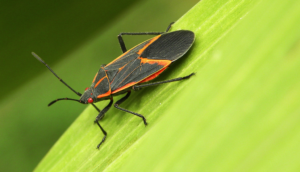
Boxelder bugs are one of the most common pests in NC. These slow-moving insects grow to be about half an inch tall as an adult. The adolescent boxelder bugs can easily be distinguished thanks to their red abdomens and lack of wings. Adult boxelder bugs, on the other hand, are grey-black with three red lines across the thorax (the part just behind the head) and across each wing.
Why They Are a Pest
These insects like to feed on softer plant tissues like leaves, flowers, and newly sprouted twigs. Their population fluctuates year to year, and during the years when their population soars they can permanently damage useful shade trees. In autumn, they can become obnoxious indoor pests and once boxelder bugs have entered the home, controlling them becomes more difficult. The adult insects seek places to hibernate during the winter, thus finding their way into homes and buildings. On top of producing an unpleasant odor when crushed, they can stain draperies and other light-colored surfaces as well. Fortunately, they don’t reproduce during the winter, so treating infestations is ideal during this time.
How to Get Rid of This Pest
A permanent solution for a boxelder bug problem is to remove the female boxelder trees (only female trees produce the seed pods) from your neighborhood, although this may not be practical or desirable. Because boxelder bugs usually hibernate near the trees they feed on, the removal of one or two ‘problem’ trees might help. Additionally, sealing cracks and other entrances into your home is a simple way to keep them at bay. When the bugs begin to congregate on building exteriors, these areas (including all resting and hiding places) need to be sprayed with residual insecticides to effectively exterminate them.
2. Earwigs
What This Pest Looks Like
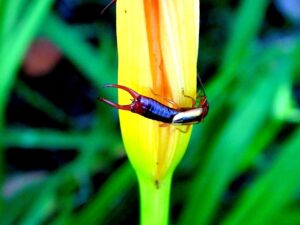
Earwigs are one of the most bizarre looking pests on this list. As adults, they can grow up to one inch long with an elongated, flat body. The red legged earwig is a native species common in the South and Southwest regions (especially here in the Carolinas). These insects have pincers called “cerci” that are used as both offensive and defensive weapons. They can even be used to capture prey! Earwigs also have an unpleasant odor that’s released when they’re crushed so be mindful of that when killing them.
Why They Are a Pest
Earwigs like to live in groups, so if you find one just know there’s probably more of these common pests lurking somewhere nearby. Red legged earwigs can invade homes, sometimes by the hundreds of thousands. These insects love to feed on live (or dead) plants and insects. At times they can damage cultivated plants which can be frustrating for homeowners trying to keep their gardens and lawn healthy.
How to Get Rid of This Pest
This pest is nocturnal and likes to stay hidden during the day. You can find them in moist and shaded places. A few favorite places include underneath stones, logs, or mulch. The key to controlling them is getting rid of unnecessary debris around your yard. The purpose of this is to establish a low moisture zone that is disagreeable to earwigs. Adding diatomaceous earth or Boric acid along the exterior foundation wall is also an effective and eco-friendly treatment for these common pests.
3. Smoky Brown Cockroaches
What This Pest Looks Like
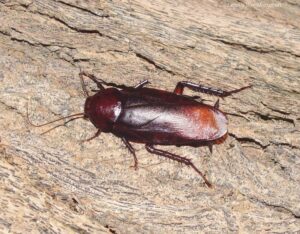
You can spot a smoky brown cockroach by their rich mahogany color. They can grow to 1.5 inches in length and have a set of long wings. Lucky for us, young nymphs are unable to fly. Unlucky for us, these cockroaches will be able to take flight one they reach adulthood.
Why They Are a Pest
The reason these common pests are not welcome in our homes is because they’re known to be filthy. All cockroach species have negative health consequences to humans. Their feces are contaminated with allergens that can trigger reactions such as asthma. They also contaminate food and water supplies in our homes and businesses.
How to Get Rid of This Pest
Smoky brown cockroaches require high humidity for survival and are usually found outside in wooded areas that provide shade and moisture. Stacks of lumber and firewood, sewer-access openings, and accumulating trash piles can contribute to infestations. Eliminate any conditions which encourage the presence and reproduction of the roaches. Take the time to spray exteriors with a cockroach insecticide. Spray any exterior cracks, crevices, or entry points that lead inside. You can also spray tree trunks and any mulched areas without problem. Exterior surfaces should be treated three to four times per year to prevent these common pests in NC. If necessary, you can also spray indoors in the following areas: basements, garages, carports, attics, closets, and laundry rooms. Also treat beneath and behind large appliances (refrigerators, stoves, etc.) or other areas where these roaches can hide. Indoor areas will also need to be sprayed two to three times per year to prevent infestations.
4. American Cockroaches
What This Pest Looks Like
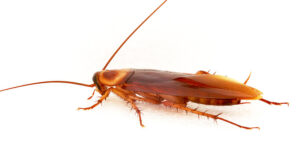
This type of cockroach is the most common species in the US. The American cockroach ranges in size from 1 3/8 inches to 2 1/8 inches in length. Compared to the Smoky Brown variety, this common pest is generally lighter in color. Although they rarely fly, if they start from a high point, like a tall tree, they can glide for a good distance.
Why They Are a Pest
American cockroaches can be found in residences, but are much more common in larger commercial buildings. Restaurants, warehouses, food processing plants, basements, and steam tunnels are a handful of places they tend to infest. American cockroaches feed on a wide variety of materials and are not picky. A short list of their favorites include cosmetics, beer, potted plants, wallpaper paste, soap, postage stamps, fermenting fruit, pet food, and all types of human food. The bad news is that they contaminate human food, clothing, paper goods, and surfaces because they’re a vector of all sorts of bacterial and viral pathogens, including Salmonella and Poliomyelitis.
How to Get Rid of This Pest
Oddly enough, American cockroaches produce a strong and unpleasant odor that is transferred to items they come into contact with. A pest management professional can often detect an American cockroach infestation just by smell before actually spotting any insects. Elimination is achieved by a combination of proper sanitation, use of pesticides applied to critical entry points, and strategically placed baits.
5. House Flies
What This Pest Looks Like
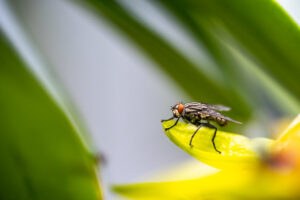
This next common pest is one we’ve all dealt with. House flies are not only common pests in NC, but all over the world. Less than ¼ inch long, these are the most annoying pests of the bunch. They have robust bodies and two clear wings that make them powerful fliers. Similar to bees, they produce a noticeable buzzing sound when flying nearby.
Why They Are a Pest
One reason why house flies are seen as a pest is because of how quickly they reproduce. Within one day of being laid, their eggs can hatch into maggots. After four to six days as maggots, these common pests turn into adult house flies. Plus, house flies are extremely unsanitary. They regurgitate food wherever they land and can spread a host of diseases and bacteria this way.
How to Get Rid of This Pest
House flies are one of the easiest pests to get rid of. The basic principles of house fly control are sanitation and non-chemical measures like essential oils. A handy dandy fly swat will also do the trick!
6. Borer Beetles
What This Pest Looks Like
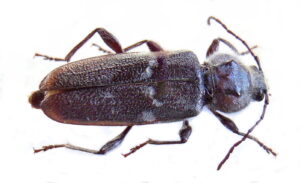
Old House Borer Beetles range in color from black to gray and are only about 5/8 to 1 inch in length. They have long antennae and almost look similar to cockroaches in shape.
Why They Are a Pest
Without a doubt, this beetle is one of the most destructive common pests in NC. These beetles chew into wood, damaging structures and destroying trees. Unlike their name suggests, old house borer beetles prefer to munch on freshly cut wood and are commonly found in newer homes.
How to Get Rid of This Pest
There are several ways to prevent these beetles from boring into your home’s structure or your beloved trees. First, sand and seal wood surfaces to repel the beetles and stop them from attacking the wood. They won’t stick around as long as they can’t find crevices in the wood surface to deposit their eggs. For newly hatched larvae, use surface sprays containing borates so that they’re unable to chew through lumber. Keep in mind, this technique is not effective on wood that has already been varnished, waxed, or otherwise sealed for moisture.
7. Fruit Flies
What This Pest Looks Like

Out of all the common pests in NC, the fruit fly has to be the smallest. Fruit flies are only about three millimeters long and look like a miniature version of a house fly. The only difference is their unique red eyes and the fact that they’re completely silent when flying, making them hard to notice.
Why They Are a Pest
Fruit flies are attracted to decomposing fruits and vegetables, which is why you’ll usually find them hovering over your fruit bowl on the counter. Incredibly, a single rotting potato or fruit juice spillage under a refrigerator is all that’s needed to breed thousands of fruit flies. Aside from being a nuisance, they spread bacteria and can contaminate our food.
How to Get Rid of This Pest
The best way to avoid problems with fruit flies is to eliminate sources of attraction. Ripe produce should be immediately eaten, discarded, or refrigerated. Cracked or damaged portions of fruits and vegetables should be cut away and discarded in the event that eggs or larvae are present in the exposed areas.
8. Yellow Jackets
What This Pest Looks Like
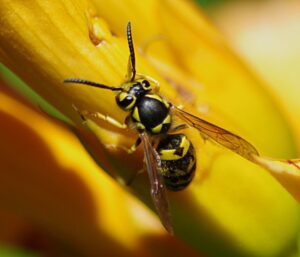
Native to North Carolina is the southern yellow jacket, named for their yellow and black color pattern. The queen of the southern yellow jackets will always look different from her workers because she’s very large (and in charge) and predominantly orange rather than yellow.
Why They Are a Pest
In general, yellow jackets are beneficial insects because they kill numerous flies, caterpillars, beetle larvae, and other arthropod pests. However, because of their stinging ability and propensity to nest in residential and recreational areas, they can be hazardous to people and animals. Each yellow jacket can inflict numerous painful stings (think bees but even more aggressive), which often result in painful swelling and subsequent itching. At least 15 to 20 people die each year in the United States as a result of anaphylactic shock following yellow jacket stings. Even worse, a single sting from an alarmed yellow jacket can excite others to follow suit and attack as well.
How to Get Rid of This Pest
Contrary to popular belief, yellow jacket nests can be dealt with naturally and without the use of toxic chemicals. Underground colonies are easily killed by treating the entrance holes with diatomaceous earth or by placing a large bowl over the nest’s entrance to trap them from going in or out. For nests above the ground, make a simple DIY wasp nest that lures them into a bottle where they can’t find their way out.
9. Mice
What This Pest Looks Like
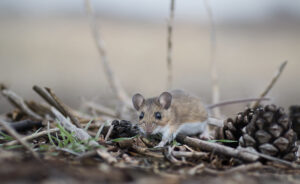
We have two species of mice that are very common pests in NC — the deer mouse and white footed mouse. First is the deer mouse, the more common of the two. Its head and body are roughly two to three inches long with its tail adding a few more inches in length. The deer mouse’s upper body ranges from a light gray to reddish brown, depending on its age. The underbelly and tail is always white. The white footed mouse looks very similar to the deer mouse so they can be hard to tell apart. The head and body together are only about four inches long with a short tail that’s usually no longer than two inches. Topside, its fur ranges from pale brown to reddish brown, while its underside and feet are also completely white.
Why They Are a Pest
All types of mice are not only destructive, but also spread diseases and bacteria more than any other type of pest. These two common pests are known to carry Hantavirus, which causes Hantavirus Pulmonary Syndrome (HPS). This severe virus is transmitted by inhaling dust particles contaminated with urine and feces from infected white footed or deer mice.
How to Get Rid of This Pest
At-home efforts to get rid of these two common pests include glue traps and snap traps. If using these methods, be sure to wear rubber or plastic gloves when handling mice or traps and disinfect any droppings you find since diseases can also be spread this way. The easiest method is to hire a professional pest control company to remove pests from your home without you having to lift a finger. Nowadays, pest control has become very advanced — with smart data doing all the work when it comes to tracking and trapping rodents. Common pests are evolving, and so are the methods for exterminating them!
The Killingsworth Way of Dealing with Common Pests in NC
Pests are nothing more than that — a pest. While they’re not welcome in our homes for many reasons, getting rid of them can be a pain. Here at Killingsworth, we do things differently when it comes to pest control. We focus on identifying pests, treating them, and eliminating them in ways that are safe for you and your home. To schedule a pest removal service or sign up for a free inspection, fill out the form on our pest control page today!